Students study the sound of music

Left: First and second graders learn the gayageum (12-string zither-like instrument) at Changchon Elementary School in Mapo District, western Seoul. Right: On the afternoon of June 13 at the main music room of Myonmok Middle School in Jungrang District, eastern Seoul, 8th graders of one homeroom class learn the ukulele. At this school, all 8th graders are taught ukulele. [KIM SEONG-RYONG]
“It’s an instrument I’m learning for the first time,” said 14-year-old Jeong Ji-seong, “but the sound is so beautiful and whenever I get the notes right, it’s like, ‘Whoa, I did it,’ and I relax, I get into the music and my stress disappears.”
This is part of Myonmok Middle School’s “one student, one instrument” program, which the Jungrang District Office, Seoul Metropolitan Office of Education and Ministry of Education began supporting for all its 7th and 8th graders. As part of the program, 7th graders may choose from an assortment of string instruments such as violas, cellos and double basses, while 8th graders learn to play the ukelele. All classes are free.
“On music days, I wait for class all day long,” said 8th grader Yang Hye-min. “Students at our school can all play at least one instrument.”
This year, 1,031 elementary, middle and high schools received funds from the Seoul Metropolitan Office of Education to hire arts teachers, and 240 were recipients of instrument procurement aid for their orchestras. A total of 173 Seoul middle schools are also implementing integrated culture and arts programs in which students may study a semester of musicals, dramas or movies, depending on the school.
“I thought middle school would be boring but after learning an instrument, school is really fun,” said Kim Tae-hee, a Myonmok 8th grader who is learning viola.
“Our school is very good at unity,” said Yong Han-bin, a 10th grader at the school, “because we teach and learn from each other and we talk a lot with our friends. You can make friends when classmates gather to play, even with a friend who was a bit awkward at first.”
These increased student interactions have also led to a reduction in school-related violence. According to an annual survey on school-related violence, the percentage of respondents who said they had experienced violence dropped to 1.1 percent in the first semester this year compared to 3.3 percent in the first semester of 2014.
“Since children began to feel school was a fun place,” said Lee Eun-suk, the principal of Myonmok, “their faces have become brighter.”
At Guro Middle School, all 9th graders began attending music classes in 2011. Now Guro students learn songs and choreography from a professional musical lecturer and are assigned production, lighting and sound work, as well - and perform their musicals at graduation.
“After the 9th graders finished performing musicals, they went backstage to exchange congratulations and cried while embracing each other,” said Hong Jin-pyo, head of the creative experiences department. “The musical class was where they struggled together, smashing down the wall between students and teachers.”
Starting from 2015, Changdeok Girls’ Middle School in Seoul began offering cultural arts education to all students in the 7th and 8th grades. In the first semester, every Wednesday, 8th graders attended a two-hour musical course. In the second semester, 7th graders took pottery, crafts, design, caricature and creative art classes.
Musical class is an inter-disciplinary course that ties together Korean language, social studies, music and art. This year 8th graders studied under the musical theme “Classic Narratives in the Pansori (Korean musical storytelling) World.”
In Korean class, students studied Korean literary classics such as “The Story of Chunhyang.” In music class, they learned songs and choreography and they drew the stage backgrounds in their art class.
“We tweaked the rabbit character in Beoljubujeon (a classic Korean literary tale), which represents girls, and imbued it with a little bit more fiery character and conviction,” said an 8th grader named Choi Yun-seong. “The whole class pitched their ideas as a group and finished the scenarios.”
The results have not only improved the artistic and social performance of students, but their academic performance, as well. The Korean Educational Development Institute (KEDI) evaluated Changdeok’s elementary, middle and high school students last year. The results indicated students were higher than average when it came to initiative for self-learning, use of knowledge, creative thinking, communication and civic consciousness.
As an example, 9th graders at Changdeok scored 3.8 out of 5.0 compared to the national average of 3.2.
“Arts education nurtures confidence and, of course, self-expression,” said Lee Hwa-seong, the principal. “The number of students positively engaging in presentation and discussion during classes has subsequently increased.”
The academic community also stresses the effectiveness of arts education for teenagers.
A Seoul National University research team recently published a study titled “Research on the analysis of the effects of an integrated approach on culture and arts education,” in which it claimed, “Arts education is not just sentimental, but also improves students’ sociability and cognitive abilities.”
“Arts education develops the brain’s limbic cortex responsible for emotion and arts education once again stimulates the frontal, temporal lobe, parietal lobes and reinvigorates the entire brain,” said Suh Yoo-hun, the head of the Neuroscience Research Institute of Gachon Univeristy.
The Seoul Education Office is planning on expanding individual school’s arts education.
“This year, the integrated approach to culture and arts education started at 173 middle schools is planned to expand to all Seoul middle schools by 2020,” said Kim Jin-hee, the school commissioner of the creative arts education contribution team. “To secure at least one arts activity for 7th graders per school, we will increase our support.”
BY JEONG HYEON-JIN [hwang.hosub@joongang.co.kr]










with the Korea JoongAng Daily
To write comments, please log in to one of the accounts.
Standards Board Policy (0/250자)